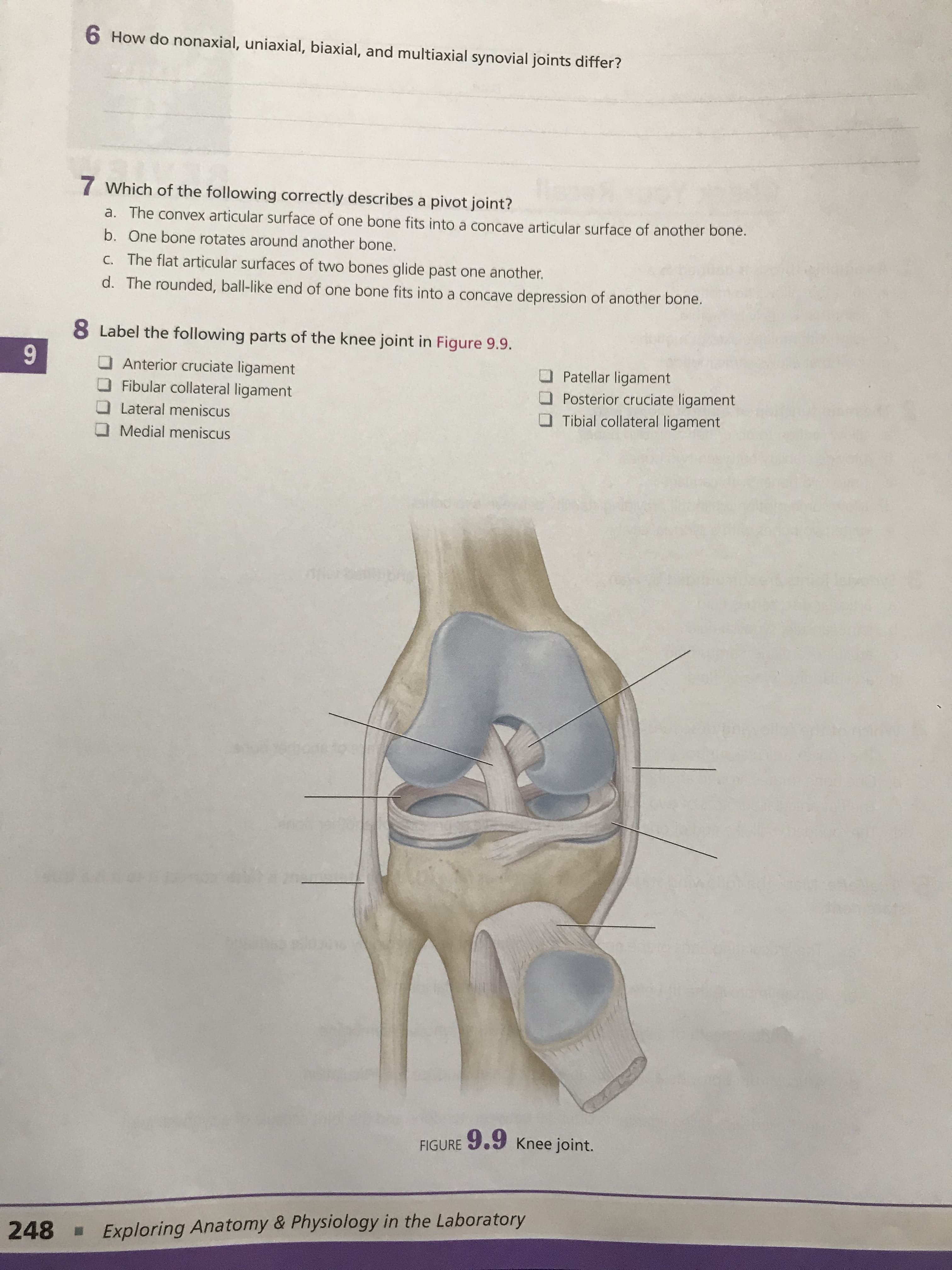6 How do nonaxial, uniaxial, biaxial, and multiaxial synovial joints differ? 7 Which of the following correctly describes a pivot joint? a. The convex articular surface of one bone fits into a concave articular surface of another bone. b. One bone rotates around another bone. c. The flat articular surfaces of two bones glide past one another d. The rounded, ball-like end of one bone fits into a concave depression of another bone. 8 Label the following parts of the knee joint in Figure 9.9. Anterior cruciate ligament Fibular collateral ligament Patellar ligament 3 Posterior cruciate ligament ■ Lateral meniscus Tibial collateral ligament Medial meniscus FIGURE 9.9 Knee joint. 248 Exploring Anatomy & Physiology in the Laboratory
6 How do nonaxial, uniaxial, biaxial, and multiaxial synovial joints differ? 7 Which of the following correctly describes a pivot joint? a. The convex articular surface of one bone fits into a concave articular surface of another bone. b. One bone rotates around another bone. c. The flat articular surfaces of two bones glide past one another d. The rounded, ball-like end of one bone fits into a concave depression of another bone. 8 Label the following parts of the knee joint in Figure 9.9. Anterior cruciate ligament Fibular collateral ligament Patellar ligament 3 Posterior cruciate ligament ■ Lateral meniscus Tibial collateral ligament Medial meniscus FIGURE 9.9 Knee joint. 248 Exploring Anatomy & Physiology in the Laboratory
Biology: The Dynamic Science (MindTap Course List)
4th Edition
ISBN:9781305389892
Author:Peter J. Russell, Paul E. Hertz, Beverly McMillan
Publisher:Peter J. Russell, Paul E. Hertz, Beverly McMillan
Chapter43: Muscles, Bones, And Body Movements
Section: Chapter Questions
Problem 9TYK
Related questions
Question

Transcribed Image Text:6 How do nonaxial, uniaxial, biaxial, and multiaxial synovial joints differ?
7 Which of the following correctly describes a pivot joint?
a. The convex articular surface of one bone fits into a concave articular surface of another bone.
b. One bone rotates around another bone.
c. The flat articular surfaces of two bones glide past one another
d. The rounded, ball-like end of one bone fits into a concave depression of another bone.
8 Label the following parts of the knee joint in Figure 9.9.
Anterior cruciate ligament
Fibular collateral ligament
Patellar ligament
3 Posterior cruciate ligament
■ Lateral meniscus
Tibial collateral ligament
Medial meniscus
FIGURE 9.9 Knee joint.
248 Exploring Anatomy & Physiology in the Laboratory
Expert Solution
This question has been solved!
Explore an expertly crafted, step-by-step solution for a thorough understanding of key concepts.
This is a popular solution!
Trending now
This is a popular solution!
Step by step
Solved in 4 steps

Recommended textbooks for you

Biology: The Dynamic Science (MindTap Course List)
Biology
ISBN:
9781305389892
Author:
Peter J. Russell, Paul E. Hertz, Beverly McMillan
Publisher:
Cengage Learning

Anatomy & Physiology
Biology
ISBN:
9781938168130
Author:
Kelly A. Young, James A. Wise, Peter DeSaix, Dean H. Kruse, Brandon Poe, Eddie Johnson, Jody E. Johnson, Oksana Korol, J. Gordon Betts, Mark Womble
Publisher:
OpenStax College

Biology 2e
Biology
ISBN:
9781947172517
Author:
Matthew Douglas, Jung Choi, Mary Ann Clark
Publisher:
OpenStax

Biology: The Dynamic Science (MindTap Course List)
Biology
ISBN:
9781305389892
Author:
Peter J. Russell, Paul E. Hertz, Beverly McMillan
Publisher:
Cengage Learning

Anatomy & Physiology
Biology
ISBN:
9781938168130
Author:
Kelly A. Young, James A. Wise, Peter DeSaix, Dean H. Kruse, Brandon Poe, Eddie Johnson, Jody E. Johnson, Oksana Korol, J. Gordon Betts, Mark Womble
Publisher:
OpenStax College

Biology 2e
Biology
ISBN:
9781947172517
Author:
Matthew Douglas, Jung Choi, Mary Ann Clark
Publisher:
OpenStax

Fundamentals of Sectional Anatomy: An Imaging App…
Biology
ISBN:
9781133960867
Author:
Denise L. Lazo
Publisher:
Cengage Learning